Apr 16, 2024
Apr 16, 2024
Akbar’s long reign was a period of expansion and consolidation. He was not only tireless in the battlefield, but proved to be a man of exceptionally fine taste in art and architecture. To him also goes the credit of refining Sher Shah’s administrative systems and putting in place a regular source of revenue for the empire which stretched over all of North India and was beginning to threaten the Deccan.
The Mughals in fact throughout the length of their dynasty were known for their good taste, right from Babur to the last ill-fated emperor, Bahadur Shah Zafar. Jahangir, son of Akbar, was no less refined, and was a gifted individual. His potential, however, was greatly diminished, especially in his later years, by an addiction to drink and drugs, and he gradually came to lose all interest in the intricacies of governance, preferring to leave all in the hands of his queen, Noor Jahan.
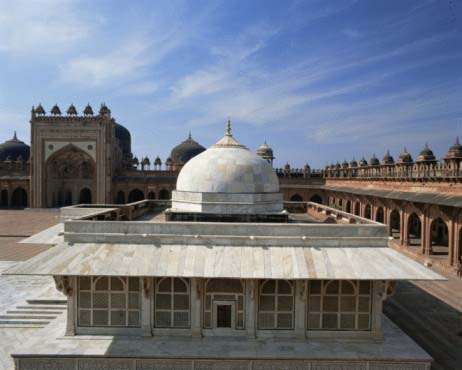 Jahangir’s sporadic bursts of coherence and creativity – very much like his grandfather, Humayun – were nevertheless enough to hold the empire together and for art and architecture to continue to flourish.
Jahangir’s sporadic bursts of coherence and creativity – very much like his grandfather, Humayun – were nevertheless enough to hold the empire together and for art and architecture to continue to flourish.
His liking for Kashmir led him to construct the Shalimar Gardens by the side of Lake Dal in Srinagar.
The exquisite dargah of Sheikh Salim Chisti at Fatehpur Sikri is also attributed to him, as are certain additions and alterations in the royal forts of Lahore, Allahabad and Agra.
However, we have to wait till the reign of Shah Jahan for the full genius of Mughal architecture to come forth. Building profusely, Shah Jahan not only changed existing forts and palaces greatly but also built an entire new city and a fort – Shahjahanabad 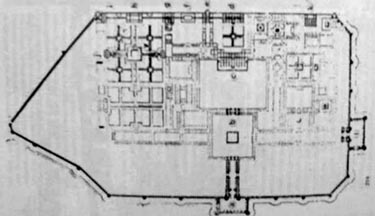 with its great Jama Masjid in Delhi and the Red Fort. But all these were to be overshadowed by the pièce de résistance – the Taj Mahal at Agra, arguably the most perfect mortuary building in all Islam. However, in continuation with our series, it would be appropriate to examine the Red Fort at Delhi in more detail.
with its great Jama Masjid in Delhi and the Red Fort. But all these were to be overshadowed by the pièce de résistance – the Taj Mahal at Agra, arguably the most perfect mortuary building in all Islam. However, in continuation with our series, it would be appropriate to examine the Red Fort at Delhi in more detail.
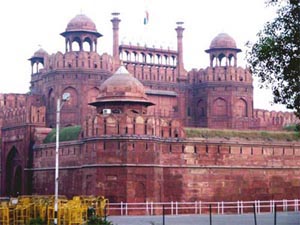 The Red Fort in plan consists of outer walls in a near-perfect rectangle except where they border the course of the Yamuna to the north.
The Red Fort in plan consists of outer walls in a near-perfect rectangle except where they border the course of the Yamuna to the north.
The walls themselves are clad with finely dressed red and pink sandstone, the joints of which are surprisingly fine. The massive round bastions set off the main Delhi and Lahore gates, massive defensive entry portals which tower over the walls. The entries from these gates meet in a square public place which finally leads off to the hall of public audience, or the Diwan-i-am.
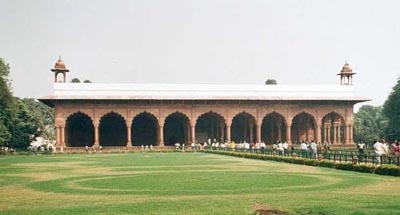
The roof of this building, today looking strangely naked and exposed, is supported on columns and arches which are more ornate than utilitarian, the simple pointed arch giving way to a multi-cusped version. Various bays of these arches make up the hall, the whole being clad in white marble with inlays of semi-precious stones. Inside the hall, the emperor’s dais is raised on a high platform.

The other buildings in the complex are the tiny Moti Masjid – a mosque entirely in marble. This, though started by Shah Jahan, was completed by his son Aurangzeb, and is different in style, with the extra decoration that was the first sign of impending decadence and decay. the Shish Mahal or the Hall of Mirrors, the treasury and magazine or Daulat Khana, the emperor’s private chambers and harems for the queens.
Running through and around most of these structures is a system of open water channels which, combined with carved marble screens fronting the river, kept the interiors amazingly cool. A visitor today to the Red Fort can still not help be surprised by the coolness of the interiors even in the hottest summer.
The Red Fort was a defensive structure, a last resort for an attack that seemed improbable and even impossible during the heyday of the Mughal empire. Who could tell that in less than a hundred years an irreversible decline would begin? Those days, however, were still far away, and outside the walls of the fort, a city flourished, full in its importance as the capital of one of the richest empires of the world.
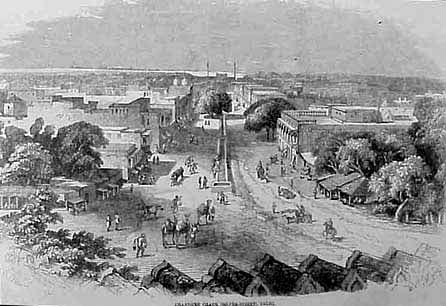
The old city of Chandni Chowk from an English drawing.
25-May-2003
More by : Ashish Nangia